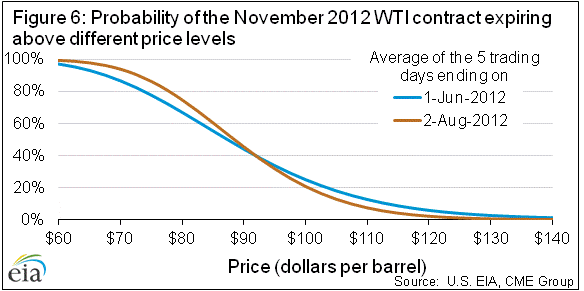Peering Into the Energy Market’s Crystal Ball
More on:
The U.S. Energy Information Adminstration (EIA) published its Short-Term Energy Outlook (STEO) on Tuesday. This report is one of three official monthly sources of data and forecasts that energy analysts often look to in order to understand market conditions. (The International Energy Agency (IEA) and the Organization of the Petroleum Exporting Countries (OPEC) release similar reports with their own numbers.)
I want to highlight one section of the STEO that should be interesting to policy and market analysts but often seems to go unnoticed. It is the analysis of "market-derived probabilities" in the “Market Prices and Uncertainty Report,” a supplement to the STEO first added in October 2009. The EIA developed it to “provide a measurement of the market’s expectations for how uncertain future energy prices are,” in the words of the EIA’s James Preciado, who helps create the report.
For the technically inclined, Preciado describes the methodology:
“We use the futures price traded on NYMEX, implied volatility, which is a trading volume weighted average of the two call option contract prices with strike prices closest to the futures price, and time to expiration as inputs into a probability model. The model is a log-normally distributed random walk, the same used in the assumptions for the Black-Scholes option pricing formula. The output is the density graph of the market’s expectation for the probability that oil prices will exceed different price points.”
The result is a snapshot of where the options markets suggest futures prices might fall at a given point down the road. Figure 6 (taken from the EIA’s August 2012 STEO) shows a measure of the probability of the November 2012 West Texas Intermediate (WTI) crude oil contract expiring above various price levels. The curve shows a 21 percent probability, in the eyes of the options market, that the November 2012 WTI futures contract will expire above $100 per barrel. That is a 4 percent decrease from two months earlier. As the EIA points out, this decrease in likelihood is likely due to the fact that, with November drawing closer, the market judged the probability of a significant uptick in prices (from their $87-$92 per barrel range in the five trading days around August 2) before then to have decreased since June. The average price and implied volatility of the underlying futures contract were “relatively unchanged” between early June and August, the EIA argues, so they weren’t the likely reason for the change in perception.
The EIA provides similar calculations for U.S. gasoline and natural gas prices (see Figures 9 and 15).
So how are these calculations useful to those interested in public policy? Here are three ways:
First, they can help bring back to Earth the sometimes wild-eyed speculation in popular rhetoric about energy markets, ala "guess where gasoline prices might go this summer” or “traders think oil prices are heading much, much higher later this year.” We’ve all heard these stories, especially in times of high economic or geopolitical uncertainty. These calculations are a first step toward putting such conversations on more informed footing by providing data-driven insight into market perceptions.
Second, these probability functions can help policy analysts understand how market participants perceive certain events, such as the onset of the Arab Spring or the 2011 IEA-coordinated SPR release, as affecting uncertainty in the oil market. Though hardly the full story, the data can supplement the kind of anecdotal evidence that is often cited in those debates about perceptions of past events or policy measures.
And third, policymakers can benefit from getting a sense of what the market’s take on potential future price conditions. Of course, futures prices are often poor predictors of actual prices. Yet policymakers often rightfully care about market perceptions. Here’s a simple (if limited) tool for getting a handle on what the energy market is thinking about the future, brought to you by the good folks at the EIA.
More on:
 Online Store
Online Store


